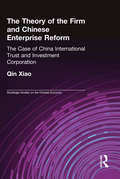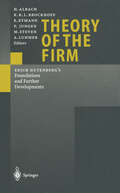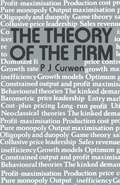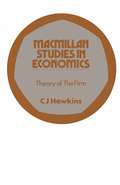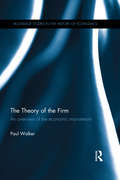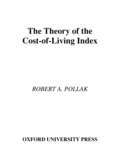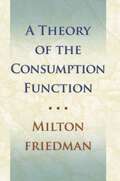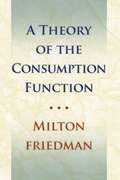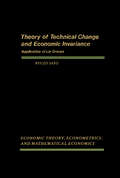- Table View
- List View
The Theory of the Firm and Chinese Enterprise Reform: The Case of China International Trust and Investment Corporation (Routledge Studies on the Chinese Economy)
by Xiao QinChanges to corporate structure, including the role of the corporate headquarters, have been key factors in bringing about economic reform in China. In this penetrating and insightful book, Xiao questions the conventional theory of the firm, arguing that the ultimate goal of the headquarters of modern large corporations is to function as a substitute for the market, and introducing a new explanation for the nature of the firm - the 'substitution function model'. He provides an insider's account of the reforms in CITIC, a rare narrative that should be essential reading for scholars and practitioners who care about the theory and practice of the firm, in particular in the context of Chinese enterprise reform.
The Theory of the Firm and Chinese Enterprise Reform: The Case of China International Trust and Investment Corporation (Routledge Studies on the Chinese Economy)
by Xiao QinChanges to corporate structure, including the role of the corporate headquarters, have been key factors in bringing about economic reform in China. In this penetrating and insightful book, Xiao questions the conventional theory of the firm, arguing that the ultimate goal of the headquarters of modern large corporations is to function as a substitute for the market, and introducing a new explanation for the nature of the firm - the 'substitution function model'. He provides an insider's account of the reforms in CITIC, a rare narrative that should be essential reading for scholars and practitioners who care about the theory and practice of the firm, in particular in the context of Chinese enterprise reform.
Theory of the Firm: Erich Gutenberg’s Foundations and Further Developments
by H. Albach K. Brockhoff E. Eymann P. Jungen M. Steven A. LuhmerThis book has an objective and a focus. It provides the reader with: • an in-depth acquaintance with the theory of the firm developed by Erich Gutenberg • an insight into a coherent body of current German research in the theory of the firm. The book is divided into two parts. The first part lays the foundations. It presents Gutenberg's theory of the firm to the English speaking reader. Considering the great importance that Erich Gutenberg has had in Germany and taking into consideration the impact that the translations of his path-breaking three volumes "Principles of Management" have had in France, the Spanish speaking countries, and in Japan, it was felt that it was necessary, on the occasion of his tOOth anniversary, to present a concise summary of his contributions to the theory of the firm to an English speaking scientific community. Six papers present Gutenberg's theory in the light of the theoretical advances that he stimulated as well as in the framework of other theoretical developments like capital market theory, transaction cost theory, principal agent theory, and contract theory. The papers show that Gutenberg's theory is highly relevant for theory and highly influential in the practice of management.
The Theory of the Firm: An overview of the economic mainstream (Routledge Studies in the History of Economics)
by Paul WalkerFirms are a ubiquitous feature of the economic landscape, with much of the activity undertaken within an economy taking place within their boundaries. Given the size of the contribution made by firms to economic activity, employment and growth, having a theoretical understanding of the nature and structure of firms is crucial for understanding how an economy functions. The Theory of the Firm firstly offers a brief overview of the past, consisting of a concise discussion of the classical view of production, followed by an outline of the development of the neoclassical - or ‘textbook’ - approach to firm level production. Secondly, the ‘present’ of the theory of the firm is discussed in three sections. The first section considers the post-1970 theory of the firm literature per se, while the second section scrutinises the relationship between the three most prominent of the modern sets of theories: the reference point, property rights and transaction cost approaches. The third section looks at the theory of privatisation. The unique aspects of this book includes its discussions of the post-1970 contributions to the theory of the firm; the integration of the theory of the entrepreneur with the theory of the firm; and the theory of privatisation. This volume offers an intuitive introduction to the theories of the firm as well as simple formal models of the most important contributions to the literature. It also outlines the historical evolution of the traditional and modern theories of the firm. This book is of great interest to those who study history of economic thought, industrial economics and organizational studies.
The Theory of the Firm: An overview of the economic mainstream (Routledge Studies in the History of Economics)
by Paul WalkerFirms are a ubiquitous feature of the economic landscape, with much of the activity undertaken within an economy taking place within their boundaries. Given the size of the contribution made by firms to economic activity, employment and growth, having a theoretical understanding of the nature and structure of firms is crucial for understanding how an economy functions. The Theory of the Firm firstly offers a brief overview of the past, consisting of a concise discussion of the classical view of production, followed by an outline of the development of the neoclassical - or ‘textbook’ - approach to firm level production. Secondly, the ‘present’ of the theory of the firm is discussed in three sections. The first section considers the post-1970 theory of the firm literature per se, while the second section scrutinises the relationship between the three most prominent of the modern sets of theories: the reference point, property rights and transaction cost approaches. The third section looks at the theory of privatisation. The unique aspects of this book includes its discussions of the post-1970 contributions to the theory of the firm; the integration of the theory of the entrepreneur with the theory of the firm; and the theory of privatisation. This volume offers an intuitive introduction to the theories of the firm as well as simple formal models of the most important contributions to the literature. It also outlines the historical evolution of the traditional and modern theories of the firm. This book is of great interest to those who study history of economic thought, industrial economics and organizational studies.
The Theory of the Cost-of-Living Index
by Robert A. PollakProviding a valuable resource for government economists, academics, and research libraries, this volume contains twelve papers by Robert Pollak--four previously unpublished--that explore the theory of the cost of living index. In addition to Pollak's classic paper, "The Theory of the Cost of Living Index," the volume includes papers on subindexes, the intertemporal cost of living index, welfare comparisons and equivalence scales, the social cost of living index, the treatment of "quality," and consumer durables in the cost of living index.
Theory of the Consumption Function (PDF)
by Milton FriedmanWhat is the exact nature of the consumption function? Can this term be defined so that it will be consistent with empirical evidence and a valid instrument in the hands of future economic researchers and policy makers? In this volume a distinguished American economist presents a new theory of the consumption function, tests it against extensive statistical J material and suggests some of its significant implications. Central to the new theory is its sharp distinction between two concepts of income, measured income, or that which is recorded for a particular period, and permanent income, a longer-period concept in terms of which consumers decide how much to spend and how much to save. Milton Friedman suggests that the total amount spent on consumption is on the average the same fraction of permanent income, regardless of the size of permanent income. The magnitude of the fraction depends on variables such as interest rate, degree of uncertainty relating to occupation, ratio of wealth to income, family size, and so on. The hypothesis is shown to be consistent with budget studies and time series data, and some of its far-reaching implications are explored in the final chapter.
Theory of the Consumption Function
by Milton FriedmanWhat is the exact nature of the consumption function? Can this term be defined so that it will be consistent with empirical evidence and a valid instrument in the hands of future economic researchers and policy makers? In this volume a distinguished American economist presents a new theory of the consumption function, tests it against extensive statistical J material and suggests some of its significant implications. Central to the new theory is its sharp distinction between two concepts of income, measured income, or that which is recorded for a particular period, and permanent income, a longer-period concept in terms of which consumers decide how much to spend and how much to save. Milton Friedman suggests that the total amount spent on consumption is on the average the same fraction of permanent income, regardless of the size of permanent income. The magnitude of the fraction depends on variables such as interest rate, degree of uncertainty relating to occupation, ratio of wealth to income, family size, and so on. The hypothesis is shown to be consistent with budget studies and time series data, and some of its far-reaching implications are explored in the final chapter.
The Theory of Technological Change and Economic Growth
by Dr Stanislaw GomulkaIn this wide ranging exposition of the various economic theories of technological change, Stanislaw Gomulka relates them to rates of growth experienced by different economies in both the short and the long term. Analysis of countries as diverse as Japan, the Soviet Union and the United Kingdom demonstrates that there is an interdependence between technological change and the institutional and cultural characteristics of different countries, which can have a profound effect on their rates of growth. All of the major, relevant models are discussed, including those of Kuznets and Phelps, but throughout the emphasis is on the creation of a unified theoretical framework to help explain the impact of technological progress on both a micro and a macro scale.
The Theory of Technological Change and Economic Growth
by Dr Stanislaw GomulkaIn this wide ranging exposition of the various economic theories of technological change, Stanislaw Gomulka relates them to rates of growth experienced by different economies in both the short and the long term. Analysis of countries as diverse as Japan, the Soviet Union and the United Kingdom demonstrates that there is an interdependence between technological change and the institutional and cultural characteristics of different countries, which can have a profound effect on their rates of growth. All of the major, relevant models are discussed, including those of Kuznets and Phelps, but throughout the emphasis is on the creation of a unified theoretical framework to help explain the impact of technological progress on both a micro and a macro scale.
Theory of Technical Change and Economic Invariance: Application of Lie Groups
by Ryuzo SatoTheory of Technical Change and Economic Invariance: Application of Lie Groups presents the economic invariance problems observable behavior under general transformations such as taste change or technical change. This book covers a variety of topics in economic theory, ranging from the analysis of production functions to the general recoverability problem of optimal dynamic behavior.Organized into nine chapters, this book begins with an overview of the theory of observable behavior by analyzing the invariant relationships among economic variables. This text then examines the Lie group theory which provides one of the most efficient methods of studying invariance properties. Other chapters consider the analysis of exogenous technical change, a process partly due to dynamic market forces of supply and demand. This book discusses as well the topics closely related to parametric changes under Lie groups and related transformations. The final chapter deals with mathematical foundations of the theory of observable market behavior.This book is a valuable resource for economists.
The Theory of Taxation and Public Economics
by Louis KaplowThe Theory of Taxation and Public Economics presents a unified conceptual framework for analyzing taxation--the first to be systematically developed in several decades. An original treatment of the subject rather than a textbook synthesis, the book contains new analysis that generates novel results, including some that overturn long-standing conventional wisdom. This fresh approach should change thinking, research, and teaching for decades to come. Building on the work of James Mirrlees, Anthony Atkinson and Joseph Stiglitz, and subsequent researchers, and in the spirit of classics by A. C. Pigou, William Vickrey, and Richard Musgrave, this book steps back from particular lines of inquiry to consider the field as a whole, including the relationships among different fiscal instruments. Louis Kaplow puts forward a framework that makes it possible to rigorously examine both distributive and distortionary effects of particular policies despite their complex interactions with others. To do so, various reforms--ranging from commodity or estate and gift taxation to regulation and public goods provision--are combined with a distributively offsetting adjustment to the income tax. The resulting distribution-neutral reform package holds much constant while leaving in play the distinctive effects of the policy instrument under consideration. By applying this common methodology to disparate subjects, The Theory of Taxation and Public Economics produces significant cross-fertilization and yields solutions to previously intractable problems.
The Theory of Taxation and Public Economics
by Louis KaplowThe Theory of Taxation and Public Economics presents a unified conceptual framework for analyzing taxation--the first to be systematically developed in several decades. An original treatment of the subject rather than a textbook synthesis, the book contains new analysis that generates novel results, including some that overturn long-standing conventional wisdom. This fresh approach should change thinking, research, and teaching for decades to come. Building on the work of James Mirrlees, Anthony Atkinson and Joseph Stiglitz, and subsequent researchers, and in the spirit of classics by A. C. Pigou, William Vickrey, and Richard Musgrave, this book steps back from particular lines of inquiry to consider the field as a whole, including the relationships among different fiscal instruments. Louis Kaplow puts forward a framework that makes it possible to rigorously examine both distributive and distortionary effects of particular policies despite their complex interactions with others. To do so, various reforms--ranging from commodity or estate and gift taxation to regulation and public goods provision--are combined with a distributively offsetting adjustment to the income tax. The resulting distribution-neutral reform package holds much constant while leaving in play the distinctive effects of the policy instrument under consideration. By applying this common methodology to disparate subjects, The Theory of Taxation and Public Economics produces significant cross-fertilization and yields solutions to previously intractable problems.
A Theory of Sustainable Sociocultural and Economic Development
by Mohamed RabieWhy do some countries' economies struggle to develop, even when they are the focus of so much research and international funding? While recognizing that the obstacles facing poor nations are many and complex, Rabie proposes that the roots of most obstacles are sociocultural; thus, sociocultural transformation and economic restructuring can only be successful when treated as interconnected, mutually beneficial objectives. A Theory of Sustainable Sociocultural and Economic Development outlines an innovative model capable of identifying the major obstacles hindering poor nations' development in general, and the sociocultural and political obstacles in particular, placing them in their proper historical contexts, and addressing them comprehensively.
A Theory of Supply Chains (Lecture Notes in Economics and Mathematical Systems #526)
by Carlos F. DaganzoThis work was stimulated by a comment made by a former student (Prof. Alan Erera of Georgia Tech) in connection with an inventory stabil ity game he was going to play in one of his logistics classes. This was the well-known "beer-game" that is often played in business schools to illus trate the "bullwhip" effect in supply chains. Al had said to me that he did not have to tell his students how to reorder replacement parts from the other members of the supply chain because he knew from experience that the order sizes the players would generate as the game progressed would become chaotic anyhow. Since I had not played the beer game, his asser tion was intriguing to me. Why would such an unstructured game always lead to the same undesirable effect? Did it have something to do with psy chology? What is it that players did to generate instabilities? I posed these to other people but could not get completely satisfactory an questions swers. Thus, the bullwhip mystery remained, at least in my mind. Since inventory chains are "conservative" systems analogous to a traffic stream, and since traffic flow models exhibit similar effects (the instability of automobile platoons and of certain numerical methods being two nota ble examples)' I suspected that traffic flow theory might shed some light on the puzzle.
A Theory of Supercritical Wing Sections, with Computer Programs and Examples: With Computer Programs and Examples (Lecture Notes in Economics and Mathematical Systems #66)
by F. Bauer P. Garabedian D. KornAt present, there is considerable interest in supercritical wing technology for the development of aircraft designed to fly near the speed of sound. The basic principle is the suppression of boundary layer separation by shifting the shock waves that occur on the wing toward the trailing edge and making them as weak as possible. The purpose of this report is to make available to the engineering public mathematical methods for the design of supercritical wings. These methods depend on the numerical solution of the partial differential equations of two-dimensional gas dynamics. The main contribution is a computer program for the design of shockless transonic airfoils using the hodograph transformation and analytic continuation into the complex domain. Another contribution is a program for the analysis of transonic flow with shocks past an airfoil at off-design conditions. In our design work we include a turbulent boundary layer correction. Part I of the paper is devoted to a description of the mathemati cal theory and need not be studied by those primarily concerned with running the programs. Part II is a manual for users of our programs which is independent of the theoretical part. In Part III and in Appendices II and III we give numerical examples and discuss computa tional results. The main substance of the report, however, is contained in the listing of the computer programs themselves in Appendix IV. We have used the Fortran language throughout and we have included numerous comment cards in the listing.
A Theory of Subjective Wellbeing (Philosophy, Politics, and Economics)
by Mark FabianThe study of 'subjective wellbeing' has seen explosive growth in recent decades, opening important new discourses in personality and social psychology, happiness economics, and moral philosophy. Now it is moving into the policy domain. In this it has arguably overstepped its limits. The shallow theoretical base of subjective wellbeing research, the limitations of its measurement instruments, and its ethical naivety makes policymaking on the basis of its findings a risky venture. The present volume is an attempt to shore up these weaknesses and set subjective wellbeing scholarship on a course for several more decades of growth and maturity. It presents a theory of subjective wellbeing in two parts. The first is the subjective wellbeing production function-a model of wellbeing as outcome. The second is the coalescence of being: a model of the self-actualisation process by which wellbeing is achieved. This two-part model integrates not only ideas in SWB studies and analytical philosophy, but also ideas from clinical, moral, and developmental psychology, continental philosophy, and welfare economics. Importantly, this theory is ethically sensitive, bridging the gap between psychological and philosophical perspectives on wellbeing that illuminates the complexities facing the application of subjective wellbeing in public policy. The book also provides a thorough review of various ways complex theories of subjective wellbeing can be studied empirically, and the hard trade offs between long surveys that capture the richness of the concept and the short surveys that are feasible in the context of social surveys and policy analysis.
A Theory of Subjective Wellbeing (Philosophy, Politics, and Economics)
by Mark FabianThe study of 'subjective wellbeing' has seen explosive growth in recent decades, opening important new discourses in personality and social psychology, happiness economics, and moral philosophy. Now it is moving into the policy domain. In this it has arguably overstepped its limits. The shallow theoretical base of subjective wellbeing research, the limitations of its measurement instruments, and its ethical naivety makes policymaking on the basis of its findings a risky venture. The present volume is an attempt to shore up these weaknesses and set subjective wellbeing scholarship on a course for several more decades of growth and maturity. It presents a theory of subjective wellbeing in two parts. The first is the subjective wellbeing production function-a model of wellbeing as outcome. The second is the coalescence of being: a model of the self-actualisation process by which wellbeing is achieved. This two-part model integrates not only ideas in SWB studies and analytical philosophy, but also ideas from clinical, moral, and developmental psychology, continental philosophy, and welfare economics. Importantly, this theory is ethically sensitive, bridging the gap between psychological and philosophical perspectives on wellbeing that illuminates the complexities facing the application of subjective wellbeing in public policy. The book also provides a thorough review of various ways complex theories of subjective wellbeing can be studied empirically, and the hard trade offs between long surveys that capture the richness of the concept and the short surveys that are feasible in the context of social surveys and policy analysis.
Theory of Stochastic Processes: With Applications to Financial Mathematics and Risk Theory (Problem Books in Mathematics)
by Dmytro Gusak Andrey Pilipenko Alexander Kukush Yuliya Mishura Alexey KulikProviding the necessary materials within a theoretical framework, this volume presents stochastic principles and processes, and related areas. Over 1000 exercises illustrate the concepts discussed, including modern approaches to sample paths and optimal stopping.
Theory of Stochastic Canonical Equations: Volumes I and II (Mathematics and Its Applications #535)
by V.L. GirkoTheory of Stochastic Canonical Equations collects the major results of thirty years of the author's work in the creation of the theory of stochastic canonical equations. It is the first book to completely explore this theory and to provide the necessary tools for dealing with these equations. Included are limit phenomena of sequences of random matrices and the asymptotic properties of the eigenvalues of such matrices. The book is especially interesting since it gives readers a chance to study proofs written by the mathematician who discovered them. All fifty-nine canonical equations are derived and explored along with their applications in such diverse fields as probability and statistics, economics and finance, statistical physics, quantum mechanics, control theory, cryptography, and communications networks. Some of these equations were first published in Russian in 1988 in the book Spectral Theory of Random Matrices, published by Nauka Science, Moscow. An understanding of the structure of random eigenvalues and eigenvectors is central to random matrices and their applications. Random matrix analysis uses a broad spectrum of other parts of mathematics, linear algebra, geometry, analysis, statistical physics, combinatories, and so forth. In return, random matrix theory is one of the chief tools of modern statistics, to the extent that at times the interface between matrix analysis and statistics is notably blurred. Volume I of Theory of Stochastic Canonical Equations discusses the key canonical equations in advanced random matrix analysis. Volume II turns its attention to a broad discussion of some concrete examples of matrices. It contains in-depth discussion of modern, highly-specialized topics in matrix analysis, such as unitary random matrices and Jacoby random matrices. The book is intended for a variety of readers: students, engineers, statisticians, economists and others.
Theory of Social Enterprise and Pluralism: Social Movements, Solidarity Economy, and Global South (Routledge Studies in Social Enterprise & Social Innovation)
by Philippe Eynaud Jean-Louis Laville Luciane Dos Santos Swati Banerjee Flor Avelino Lars HulgårdIn the past decades, social enterprise has been an emerging field of research. Its main frameworks have been provided by Occidental approaches. Mainly based on an organizational vision, they give little or no room to questions such as gender, race, colonialism, class, power relations and intertwined forms of inequality. However, a wide range of worldwide hidden, popular initiatives can be considered as another form of social enterprises based on solidarity, re-embedding the economy as well as broadening the political scope. This has been shown in a previous book: Civil Society, the Third Sector, and Social Enterprise: Governance and Democracy. Thus, to be more than a fashion or a fictitious panacea, the concept of social enterprise needs to be debated. Southern realities cannot be only understood through imported categories and outside modeled guidelines. This book engages a multicontinental and pluridisciplinary discussion in order to provide a pluralist theory of social enterprise. The book will be of interest to researchers, academics and students in the fields of social entrepreneurship, social innovation, development studies, management studies and social work.
Theory of Social Enterprise and Pluralism: Social Movements, Solidarity Economy, and Global South (Routledge Studies in Social Enterprise & Social Innovation)
by Philippe Eynaud Jean-Louis Laville Luciane Dos Santos Swati Banerjee Flor Avelino Lars HulgårdIn the past decades, social enterprise has been an emerging field of research. Its main frameworks have been provided by Occidental approaches. Mainly based on an organizational vision, they give little or no room to questions such as gender, race, colonialism, class, power relations and intertwined forms of inequality. However, a wide range of worldwide hidden, popular initiatives can be considered as another form of social enterprises based on solidarity, re-embedding the economy as well as broadening the political scope. This has been shown in a previous book: Civil Society, the Third Sector, and Social Enterprise: Governance and Democracy. Thus, to be more than a fashion or a fictitious panacea, the concept of social enterprise needs to be debated. Southern realities cannot be only understood through imported categories and outside modeled guidelines. This book engages a multicontinental and pluridisciplinary discussion in order to provide a pluralist theory of social enterprise. The book will be of interest to researchers, academics and students in the fields of social entrepreneurship, social innovation, development studies, management studies and social work.
